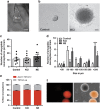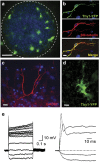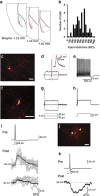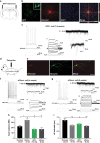Evidence for newly generated interneurons in the basolateral amygdala of adult mice
- PMID: 28809399
- PMCID: PMC5822453
- DOI: 10.1038/mp.2017.134
Evidence for newly generated interneurons in the basolateral amygdala of adult mice
Abstract
New neurons are continually generated from the resident populations of precursor cells in selective niches of the adult mammalian brain such as the hippocampal dentate gyrus and the olfactory bulb. However, whether such cells are present in the adult amygdala, and their neurogenic capacity, is not known. Using the neurosphere assay, we demonstrate that a small number of precursor cells, the majority of which express Achaete-scute complex homolog 1 (Ascl1), are present in the basolateral amygdala (BLA) of the adult mouse. Using neuron-specific Thy1-YFP transgenic mice, we show that YFP+ cells in BLA-derived neurospheres have a neuronal morphology, co-express the neuronal marker βIII-tubulin, and generate action potentials, confirming their neuronal phenotype. In vivo, we demonstrate the presence of newly generated BrdU-labeled cells in the adult BLA, and show that a proportion of these cells co-express the immature neuronal marker doublecortin (DCX). Furthermore, we reveal that a significant proportion of GFP+ neurons (~23%) in the BLA are newly generated (BrdU+) in DCX-GFP mice, and using whole-cell recordings in acute slices we demonstrate that the GFP+ cells display electrophysiological properties that are characteristic of interneurons. Using retrovirus-GFP labeling as well as the Ascl1CreERT2 mouse line, we further confirm that the precursor cells within the BLA give rise to mature and functional interneurons that persist in the BLA for at least 8 weeks after their birth. Contextual fear conditioning has no effect on the number of neurospheres or BrdU-labeled cells in the BLA, but produces an increase in hippocampal cell proliferation. These results demonstrate that neurogenic precursor cells are present in the adult BLA, and generate functional interneurons, but also show that their activity is not regulated by an amygdala-dependent learning paradigm.
Conflict of interest statement
The authors declare no conflict of interest.
Figures






Similar articles
-
Inhibitory Gating of Basolateral Amygdala Inputs to the Prefrontal Cortex.J Neurosci. 2016 Sep 7;36(36):9391-406. doi: 10.1523/JNEUROSCI.0874-16.2016. J Neurosci. 2016. PMID: 27605614 Free PMC article.
-
Vasoactive Intestinal Polypeptide-Immunoreactive Interneurons within Circuits of the Mouse Basolateral Amygdala.J Neurosci. 2018 Aug 1;38(31):6983-7003. doi: 10.1523/JNEUROSCI.2063-17.2018. Epub 2018 Jun 28. J Neurosci. 2018. PMID: 29954847 Free PMC article.
-
Structural and functional characterization of dendritic arbors and GABAergic synaptic inputs on interneurons and principal cells in the rat basolateral amygdala.J Neurophysiol. 2015 Aug;114(2):942-57. doi: 10.1152/jn.00824.2014. Epub 2015 Jun 3. J Neurophysiol. 2015. PMID: 26041829 Free PMC article.
-
Ensemble coding in amygdala circuits for associative learning.Curr Opin Neurobiol. 2015 Dec;35:200-6. doi: 10.1016/j.conb.2015.10.005. Epub 2015 Nov 3. Curr Opin Neurobiol. 2015. PMID: 26531780 Review.
-
Interneuron Types and Their Circuits in the Basolateral Amygdala.Front Neural Circuits. 2021 Jun 10;15:687257. doi: 10.3389/fncir.2021.687257. eCollection 2021. Front Neural Circuits. 2021. PMID: 34177472 Free PMC article. Review.
Cited by
-
Diversity of interneurons in the lateral and basal amygdala.NPJ Sci Learn. 2020 Aug 3;5:10. doi: 10.1038/s41539-020-0071-z. eCollection 2020. NPJ Sci Learn. 2020. PMID: 32802405 Free PMC article.
-
The cellular prion protein promotes neuronal regeneration after acute nasotoxic injury.Prion. 2020 Dec;14(1):31-41. doi: 10.1080/19336896.2020.1714373. Prion. 2020. PMID: 31950869 Free PMC article.
-
Early Maternal and Social Deprivation Expands Neural Stem Cell Population Size and Reduces Hippocampus/Amygdala-Dependent Fear Memory.Front Neurosci. 2020 Jan 29;14:22. doi: 10.3389/fnins.2020.00022. eCollection 2020. Front Neurosci. 2020. PMID: 32063832 Free PMC article.
-
Prenatal and Childhood Adverse Events and Child Brain Morphology: A Population-Based Study.Apert Neuro. 2022;2:10.52294/apertureneuro.2022.2.icjo4459. doi: 10.52294/apertureneuro.2022.2.icjo4459. Epub 2022 Mar 10. Apert Neuro. 2022. PMID: 40837130 Free PMC article.
-
Postnatal and Adult Neurogenesis in Mammals, Including Marsupials.Cells. 2022 Sep 1;11(17):2735. doi: 10.3390/cells11172735. Cells. 2022. PMID: 36078144 Free PMC article. Review.
References
-
- Ming GL, Song H. Adult neurogenesis in the mammalian central nervous system. Annu Rev Neurosci 2005; 28: 223–250. - PubMed
-
- Imayoshi I, Sakamoto M, Ohtsuka T, Takao K, Miyakawa T, Yamaguchi M et al. Roles of continuous neurogenesis in the structural and functional integrity of the adult forebrain. Nat Neurosci 2008; 11: 1153–1161. - PubMed
-
- Rietze RL, Valcanis H, Brooker GF, Thomas T, Voss AK, Bartlett PF. Purification of a pluripotent neural stem cell from the adult mouse brain. Nature 2001; 412: 736–739. - PubMed
Publication types
MeSH terms
Substances
LinkOut - more resources
Full Text Sources
Other Literature Sources
Molecular Biology Databases
Miscellaneous

